Hotel Adonis: Analysis and Design of a New Information System Project
VerifiedAdded on 2021/04/21
|16
|2934
|22
Project
AI Summary
This project provides a comprehensive analysis and design of a new information system for Hotel Adonis, a boutique hotel in Singapore. The project begins with an introduction to the organization, outlining its business goals, which include enhanced customer relationship management, improved communication, and better reporting. A flow chart illustrates the main business processes, followed by a class diagram describing the system's classes. The project explores different system acquisition choices, with a recommendation for Commercial Off-the-shelf Software (COTS). It defines the project's objectives, conducts a feasibility study covering budget, technology, and project team aspects, and details both functional and non-functional system requirements. The assignment includes a use case diagram and a conceptual model to represent the system's design and data relationships, along with hardware requirement specifications.
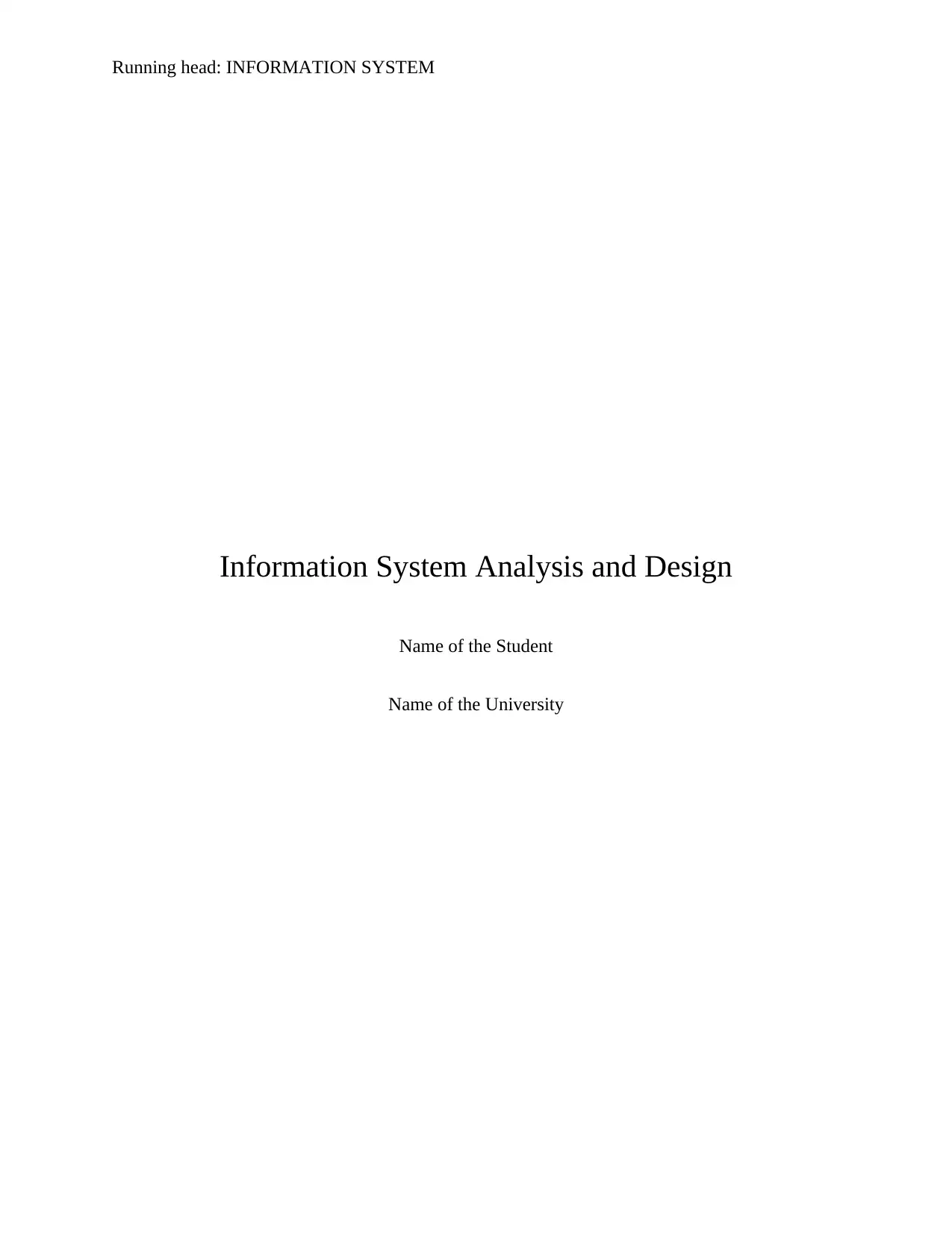
Running head: INFORMATION SYSTEM
Information System Analysis and Design
Name of the Student
Name of the University
Information System Analysis and Design
Name of the Student
Name of the University
Paraphrase This Document
Need a fresh take? Get an instant paraphrase of this document with our AI Paraphraser
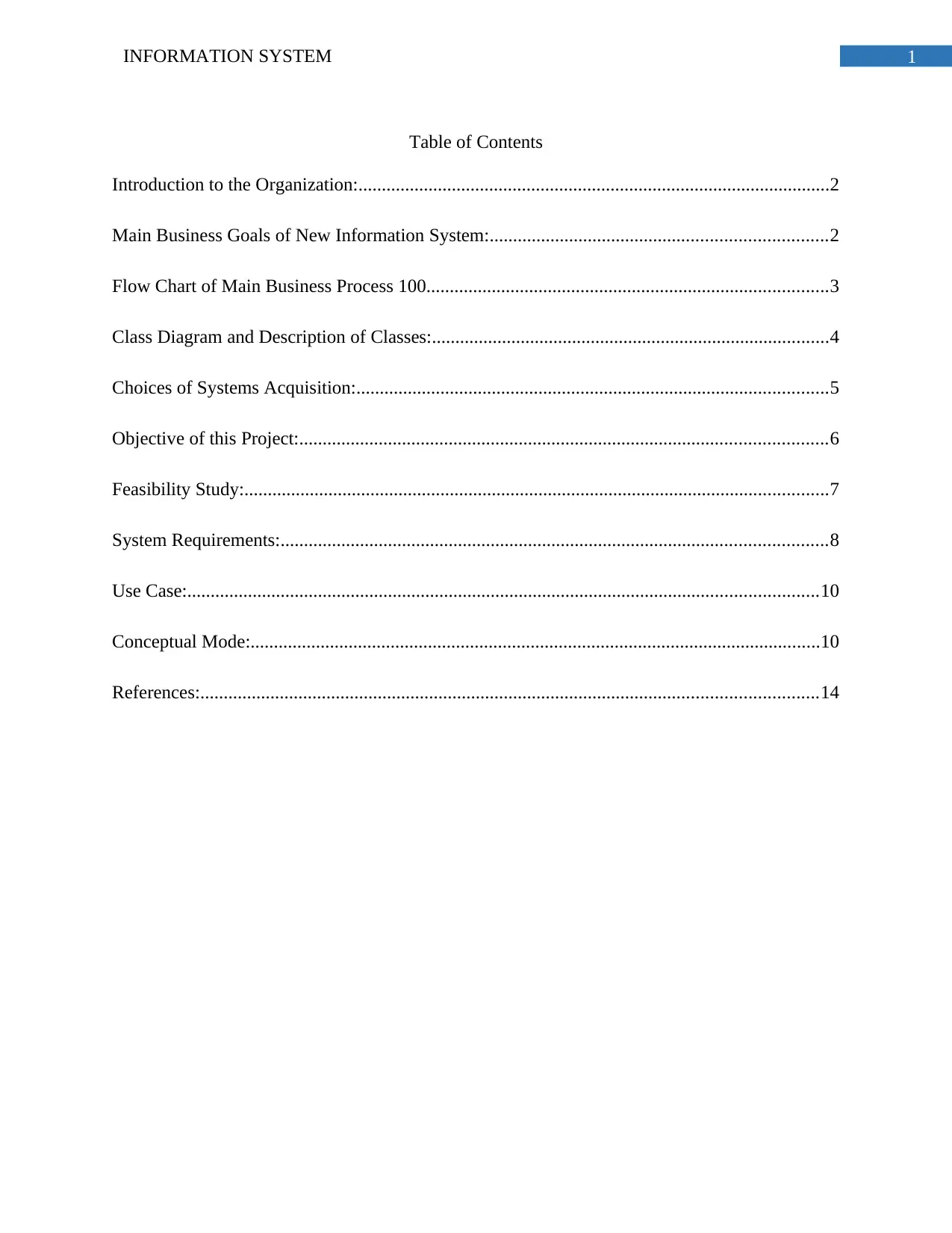
1INFORMATION SYSTEM
Table of Contents
Introduction to the Organization:.....................................................................................................2
Main Business Goals of New Information System:........................................................................2
Flow Chart of Main Business Process 100......................................................................................3
Class Diagram and Description of Classes:.....................................................................................4
Choices of Systems Acquisition:.....................................................................................................5
Objective of this Project:.................................................................................................................6
Feasibility Study:.............................................................................................................................7
System Requirements:.....................................................................................................................8
Use Case:.......................................................................................................................................10
Conceptual Mode:..........................................................................................................................10
References:....................................................................................................................................14
Table of Contents
Introduction to the Organization:.....................................................................................................2
Main Business Goals of New Information System:........................................................................2
Flow Chart of Main Business Process 100......................................................................................3
Class Diagram and Description of Classes:.....................................................................................4
Choices of Systems Acquisition:.....................................................................................................5
Objective of this Project:.................................................................................................................6
Feasibility Study:.............................................................................................................................7
System Requirements:.....................................................................................................................8
Use Case:.......................................................................................................................................10
Conceptual Mode:..........................................................................................................................10
References:....................................................................................................................................14

2INFORMATION SYSTEM
Introduction to the Organization:
The selected organization is Hotel Adonis. This hotel is located at Purvis Street,
Singapore. The hotel is built over a restored heritage building. The hotel not only provides
heritage feeling to the customers but also equips modernized infrastructure. The hotel offers
luxurious and high quality accommodation to customers. Hotel Adonis boutique hotel provides
the perfect experience to both the business and casual travelers. The hotel has six types of rooms.
The room types are Quaint Queen, Deluxe King, Premier King, Artist Suite, Explorer Suite and
Photographer Suite. Public parking is available in nearby location. For parking their vehicles, the
customers have to pay hourly charges.
The hotel is using manual processes to operate the business operations. The receptionists
accept booking through mail, calls or at hotel reception. The hotel uses a small database system.
Customers fill-up a form before check in. The receptionist records the details of the customer in
the database.
Main Business Goals of New Information System:
The primary business goal of the information system to enhance the business process
efficiency. The other goals are as following.
i. Enhanced CRM: The new system is designed with the purpose of improving the
customer relationship management of Hotel Adonis. The system will allow the
organization to communicate with the customer in a more effective way. The
customers can easily access the details of the services Hotel Adonis offers.
Submitting queries and getting solutions of the queries will require less time.
Introduction to the Organization:
The selected organization is Hotel Adonis. This hotel is located at Purvis Street,
Singapore. The hotel is built over a restored heritage building. The hotel not only provides
heritage feeling to the customers but also equips modernized infrastructure. The hotel offers
luxurious and high quality accommodation to customers. Hotel Adonis boutique hotel provides
the perfect experience to both the business and casual travelers. The hotel has six types of rooms.
The room types are Quaint Queen, Deluxe King, Premier King, Artist Suite, Explorer Suite and
Photographer Suite. Public parking is available in nearby location. For parking their vehicles, the
customers have to pay hourly charges.
The hotel is using manual processes to operate the business operations. The receptionists
accept booking through mail, calls or at hotel reception. The hotel uses a small database system.
Customers fill-up a form before check in. The receptionist records the details of the customer in
the database.
Main Business Goals of New Information System:
The primary business goal of the information system to enhance the business process
efficiency. The other goals are as following.
i. Enhanced CRM: The new system is designed with the purpose of improving the
customer relationship management of Hotel Adonis. The system will allow the
organization to communicate with the customer in a more effective way. The
customers can easily access the details of the services Hotel Adonis offers.
Submitting queries and getting solutions of the queries will require less time.
⊘ This is a preview!⊘
Do you want full access?
Subscribe today to unlock all pages.

Trusted by 1+ million students worldwide
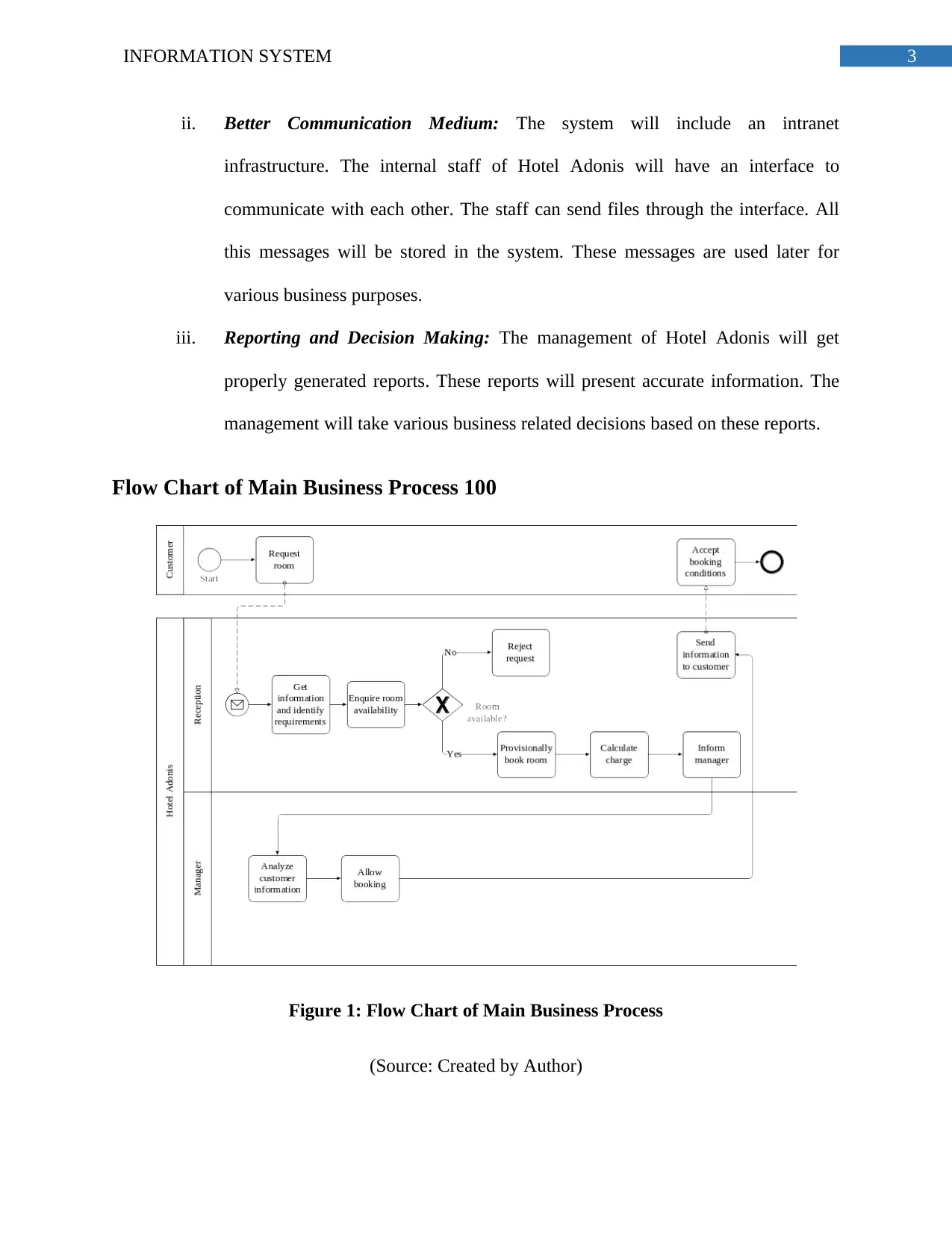
3INFORMATION SYSTEM
ii. Better Communication Medium: The system will include an intranet
infrastructure. The internal staff of Hotel Adonis will have an interface to
communicate with each other. The staff can send files through the interface. All
this messages will be stored in the system. These messages are used later for
various business purposes.
iii. Reporting and Decision Making: The management of Hotel Adonis will get
properly generated reports. These reports will present accurate information. The
management will take various business related decisions based on these reports.
Flow Chart of Main Business Process 100
Figure 1: Flow Chart of Main Business Process
(Source: Created by Author)
ii. Better Communication Medium: The system will include an intranet
infrastructure. The internal staff of Hotel Adonis will have an interface to
communicate with each other. The staff can send files through the interface. All
this messages will be stored in the system. These messages are used later for
various business purposes.
iii. Reporting and Decision Making: The management of Hotel Adonis will get
properly generated reports. These reports will present accurate information. The
management will take various business related decisions based on these reports.
Flow Chart of Main Business Process 100
Figure 1: Flow Chart of Main Business Process
(Source: Created by Author)
Paraphrase This Document
Need a fresh take? Get an instant paraphrase of this document with our AI Paraphraser
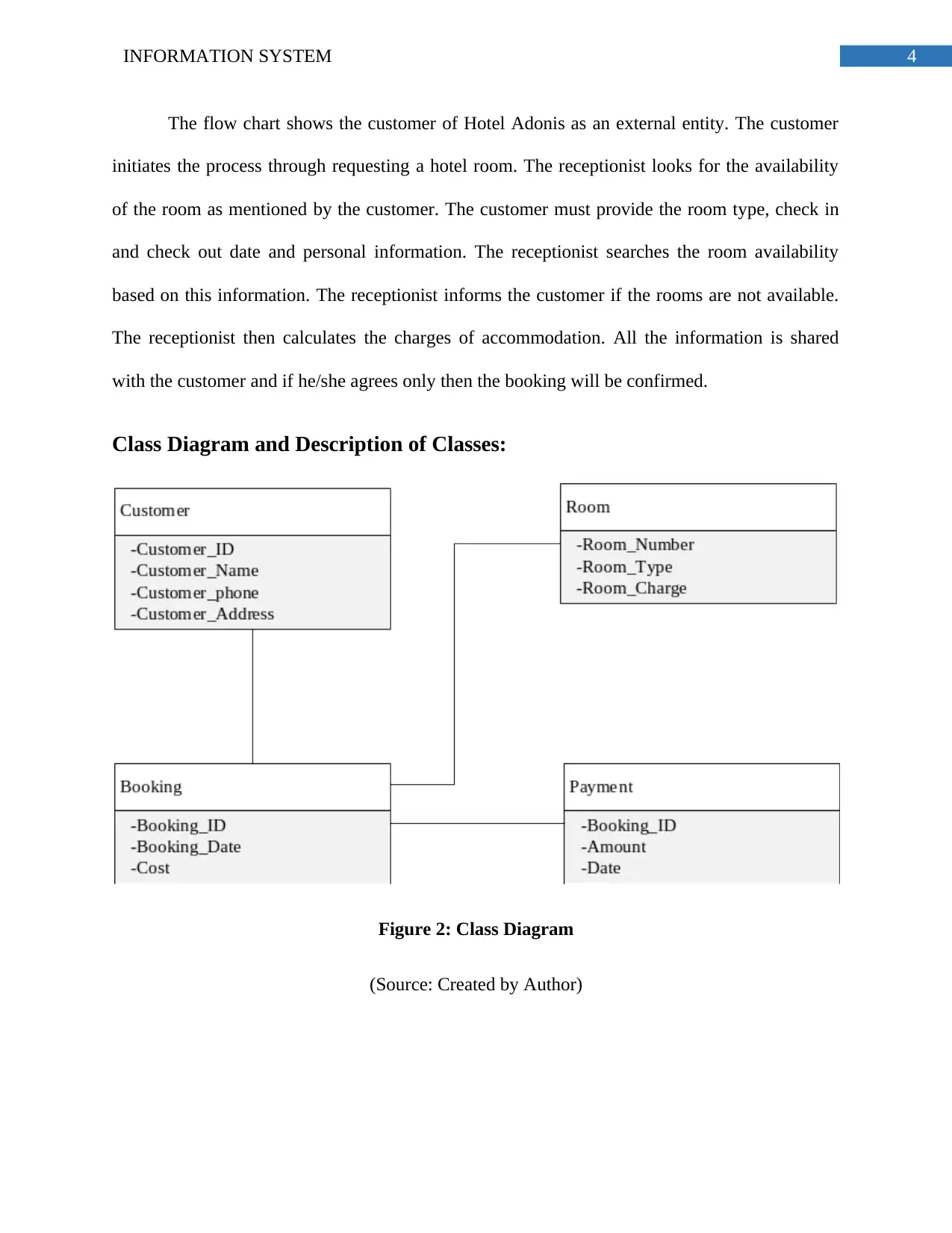
4INFORMATION SYSTEM
The flow chart shows the customer of Hotel Adonis as an external entity. The customer
initiates the process through requesting a hotel room. The receptionist looks for the availability
of the room as mentioned by the customer. The customer must provide the room type, check in
and check out date and personal information. The receptionist searches the room availability
based on this information. The receptionist informs the customer if the rooms are not available.
The receptionist then calculates the charges of accommodation. All the information is shared
with the customer and if he/she agrees only then the booking will be confirmed.
Class Diagram and Description of Classes:
Figure 2: Class Diagram
(Source: Created by Author)
The flow chart shows the customer of Hotel Adonis as an external entity. The customer
initiates the process through requesting a hotel room. The receptionist looks for the availability
of the room as mentioned by the customer. The customer must provide the room type, check in
and check out date and personal information. The receptionist searches the room availability
based on this information. The receptionist informs the customer if the rooms are not available.
The receptionist then calculates the charges of accommodation. All the information is shared
with the customer and if he/she agrees only then the booking will be confirmed.
Class Diagram and Description of Classes:
Figure 2: Class Diagram
(Source: Created by Author)
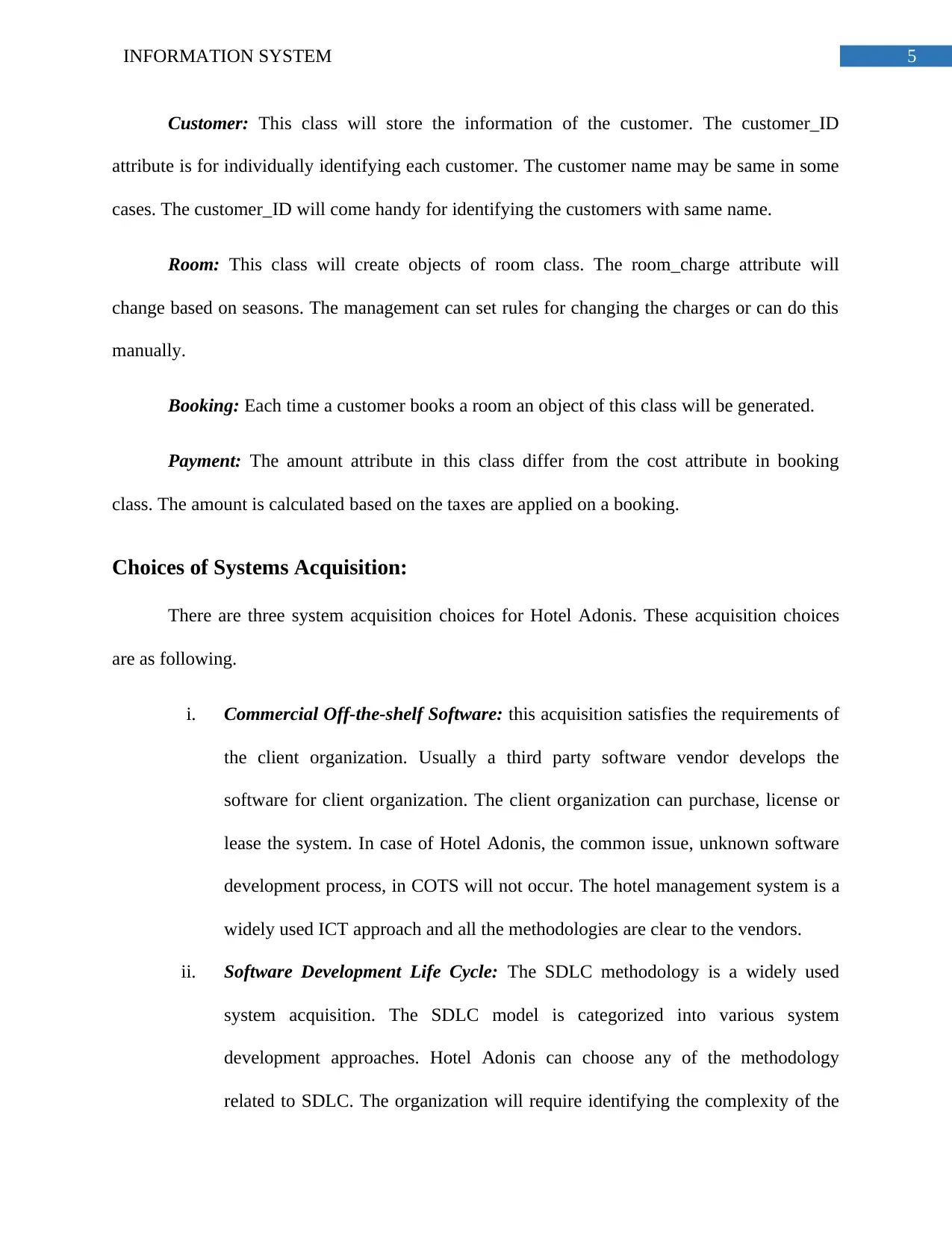
5INFORMATION SYSTEM
Customer: This class will store the information of the customer. The customer_ID
attribute is for individually identifying each customer. The customer name may be same in some
cases. The customer_ID will come handy for identifying the customers with same name.
Room: This class will create objects of room class. The room_charge attribute will
change based on seasons. The management can set rules for changing the charges or can do this
manually.
Booking: Each time a customer books a room an object of this class will be generated.
Payment: The amount attribute in this class differ from the cost attribute in booking
class. The amount is calculated based on the taxes are applied on a booking.
Choices of Systems Acquisition:
There are three system acquisition choices for Hotel Adonis. These acquisition choices
are as following.
i. Commercial Off-the-shelf Software: this acquisition satisfies the requirements of
the client organization. Usually a third party software vendor develops the
software for client organization. The client organization can purchase, license or
lease the system. In case of Hotel Adonis, the common issue, unknown software
development process, in COTS will not occur. The hotel management system is a
widely used ICT approach and all the methodologies are clear to the vendors.
ii. Software Development Life Cycle: The SDLC methodology is a widely used
system acquisition. The SDLC model is categorized into various system
development approaches. Hotel Adonis can choose any of the methodology
related to SDLC. The organization will require identifying the complexity of the
Customer: This class will store the information of the customer. The customer_ID
attribute is for individually identifying each customer. The customer name may be same in some
cases. The customer_ID will come handy for identifying the customers with same name.
Room: This class will create objects of room class. The room_charge attribute will
change based on seasons. The management can set rules for changing the charges or can do this
manually.
Booking: Each time a customer books a room an object of this class will be generated.
Payment: The amount attribute in this class differ from the cost attribute in booking
class. The amount is calculated based on the taxes are applied on a booking.
Choices of Systems Acquisition:
There are three system acquisition choices for Hotel Adonis. These acquisition choices
are as following.
i. Commercial Off-the-shelf Software: this acquisition satisfies the requirements of
the client organization. Usually a third party software vendor develops the
software for client organization. The client organization can purchase, license or
lease the system. In case of Hotel Adonis, the common issue, unknown software
development process, in COTS will not occur. The hotel management system is a
widely used ICT approach and all the methodologies are clear to the vendors.
ii. Software Development Life Cycle: The SDLC methodology is a widely used
system acquisition. The SDLC model is categorized into various system
development approaches. Hotel Adonis can choose any of the methodology
related to SDLC. The organization will require identifying the complexity of the
⊘ This is a preview!⊘
Do you want full access?
Subscribe today to unlock all pages.

Trusted by 1+ million students worldwide
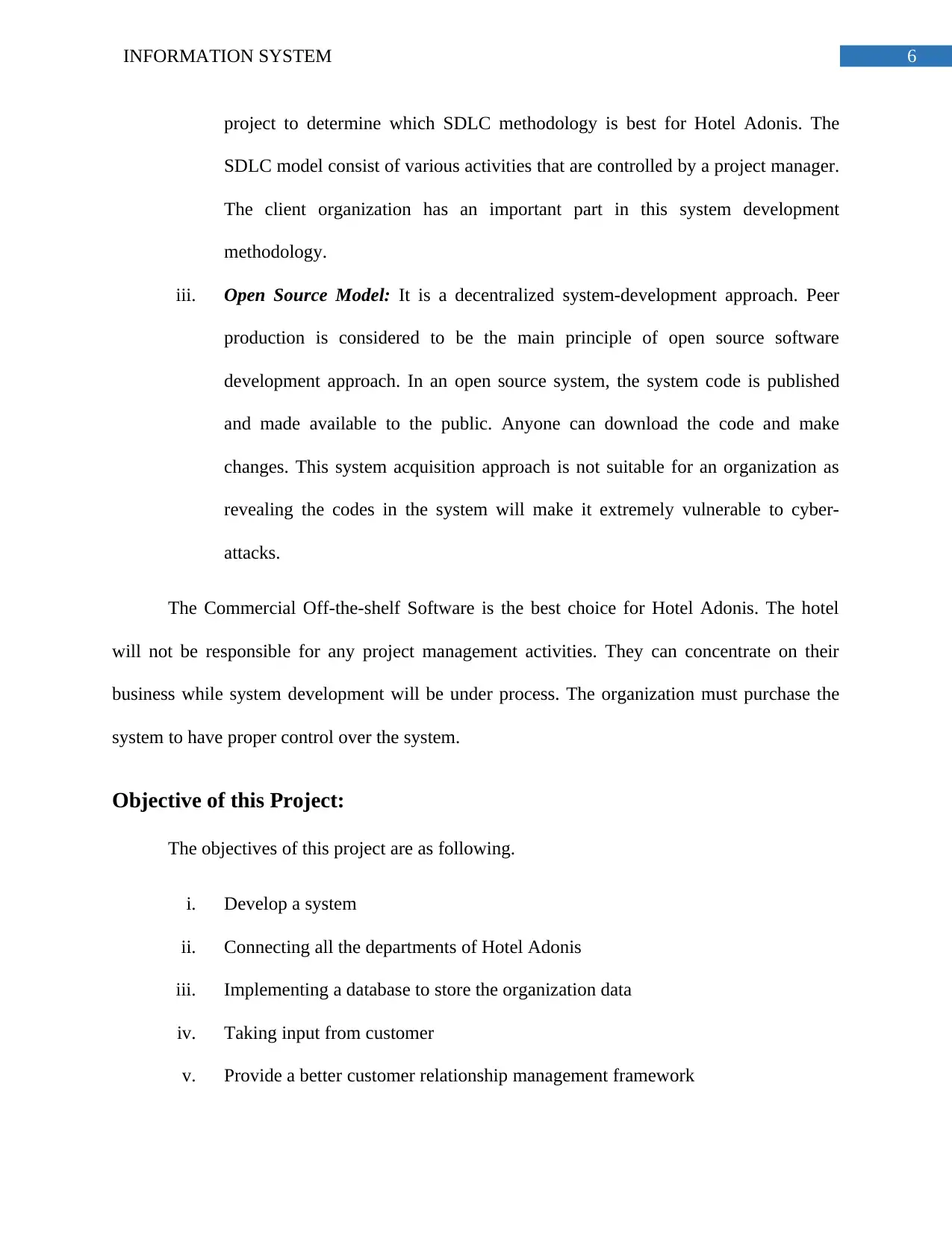
6INFORMATION SYSTEM
project to determine which SDLC methodology is best for Hotel Adonis. The
SDLC model consist of various activities that are controlled by a project manager.
The client organization has an important part in this system development
methodology.
iii. Open Source Model: It is a decentralized system-development approach. Peer
production is considered to be the main principle of open source software
development approach. In an open source system, the system code is published
and made available to the public. Anyone can download the code and make
changes. This system acquisition approach is not suitable for an organization as
revealing the codes in the system will make it extremely vulnerable to cyber-
attacks.
The Commercial Off-the-shelf Software is the best choice for Hotel Adonis. The hotel
will not be responsible for any project management activities. They can concentrate on their
business while system development will be under process. The organization must purchase the
system to have proper control over the system.
Objective of this Project:
The objectives of this project are as following.
i. Develop a system
ii. Connecting all the departments of Hotel Adonis
iii. Implementing a database to store the organization data
iv. Taking input from customer
v. Provide a better customer relationship management framework
project to determine which SDLC methodology is best for Hotel Adonis. The
SDLC model consist of various activities that are controlled by a project manager.
The client organization has an important part in this system development
methodology.
iii. Open Source Model: It is a decentralized system-development approach. Peer
production is considered to be the main principle of open source software
development approach. In an open source system, the system code is published
and made available to the public. Anyone can download the code and make
changes. This system acquisition approach is not suitable for an organization as
revealing the codes in the system will make it extremely vulnerable to cyber-
attacks.
The Commercial Off-the-shelf Software is the best choice for Hotel Adonis. The hotel
will not be responsible for any project management activities. They can concentrate on their
business while system development will be under process. The organization must purchase the
system to have proper control over the system.
Objective of this Project:
The objectives of this project are as following.
i. Develop a system
ii. Connecting all the departments of Hotel Adonis
iii. Implementing a database to store the organization data
iv. Taking input from customer
v. Provide a better customer relationship management framework
Paraphrase This Document
Need a fresh take? Get an instant paraphrase of this document with our AI Paraphraser
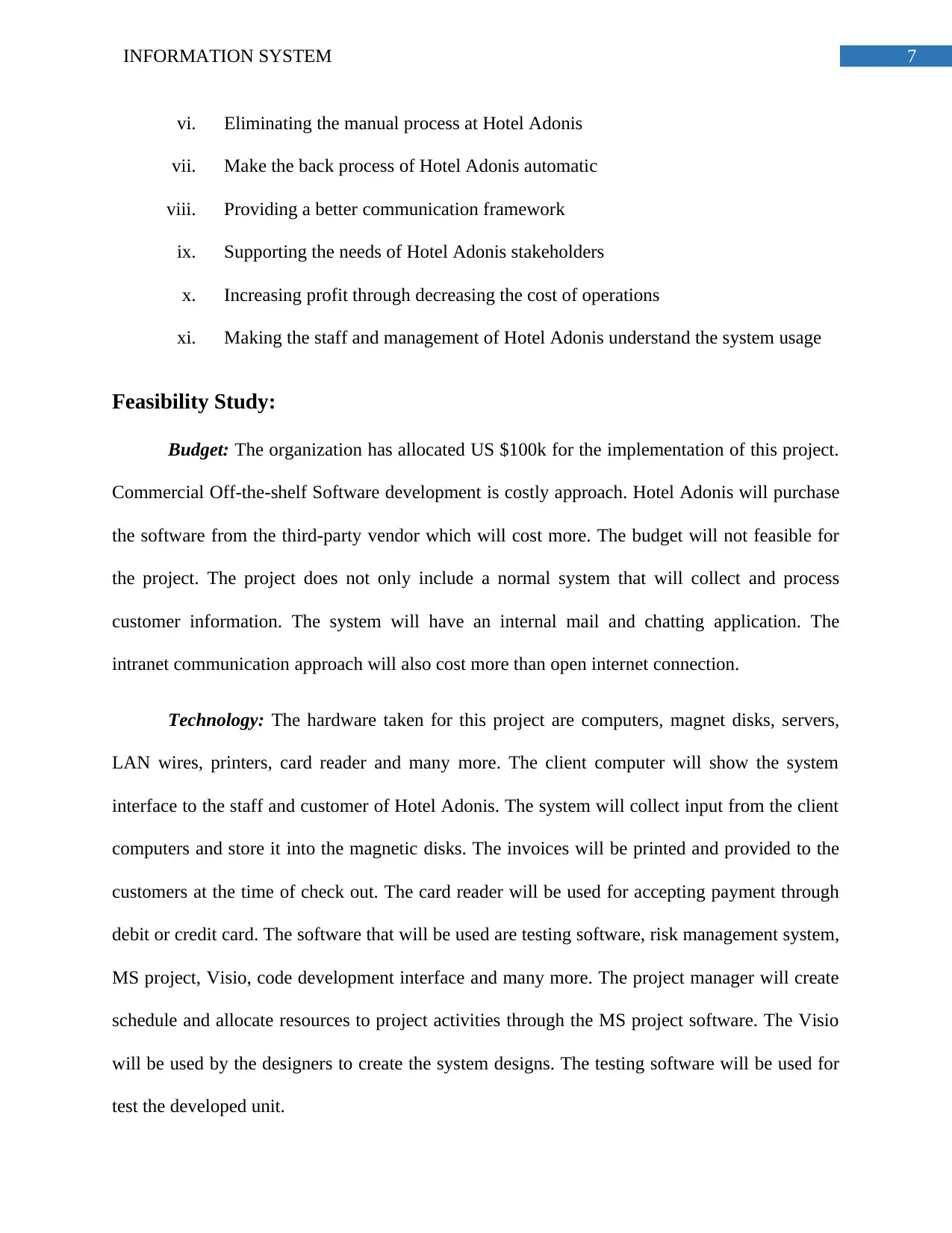
7INFORMATION SYSTEM
vi. Eliminating the manual process at Hotel Adonis
vii. Make the back process of Hotel Adonis automatic
viii. Providing a better communication framework
ix. Supporting the needs of Hotel Adonis stakeholders
x. Increasing profit through decreasing the cost of operations
xi. Making the staff and management of Hotel Adonis understand the system usage
Feasibility Study:
Budget: The organization has allocated US $100k for the implementation of this project.
Commercial Off-the-shelf Software development is costly approach. Hotel Adonis will purchase
the software from the third-party vendor which will cost more. The budget will not feasible for
the project. The project does not only include a normal system that will collect and process
customer information. The system will have an internal mail and chatting application. The
intranet communication approach will also cost more than open internet connection.
Technology: The hardware taken for this project are computers, magnet disks, servers,
LAN wires, printers, card reader and many more. The client computer will show the system
interface to the staff and customer of Hotel Adonis. The system will collect input from the client
computers and store it into the magnetic disks. The invoices will be printed and provided to the
customers at the time of check out. The card reader will be used for accepting payment through
debit or credit card. The software that will be used are testing software, risk management system,
MS project, Visio, code development interface and many more. The project manager will create
schedule and allocate resources to project activities through the MS project software. The Visio
will be used by the designers to create the system designs. The testing software will be used for
test the developed unit.
vi. Eliminating the manual process at Hotel Adonis
vii. Make the back process of Hotel Adonis automatic
viii. Providing a better communication framework
ix. Supporting the needs of Hotel Adonis stakeholders
x. Increasing profit through decreasing the cost of operations
xi. Making the staff and management of Hotel Adonis understand the system usage
Feasibility Study:
Budget: The organization has allocated US $100k for the implementation of this project.
Commercial Off-the-shelf Software development is costly approach. Hotel Adonis will purchase
the software from the third-party vendor which will cost more. The budget will not feasible for
the project. The project does not only include a normal system that will collect and process
customer information. The system will have an internal mail and chatting application. The
intranet communication approach will also cost more than open internet connection.
Technology: The hardware taken for this project are computers, magnet disks, servers,
LAN wires, printers, card reader and many more. The client computer will show the system
interface to the staff and customer of Hotel Adonis. The system will collect input from the client
computers and store it into the magnetic disks. The invoices will be printed and provided to the
customers at the time of check out. The card reader will be used for accepting payment through
debit or credit card. The software that will be used are testing software, risk management system,
MS project, Visio, code development interface and many more. The project manager will create
schedule and allocate resources to project activities through the MS project software. The Visio
will be used by the designers to create the system designs. The testing software will be used for
test the developed unit.
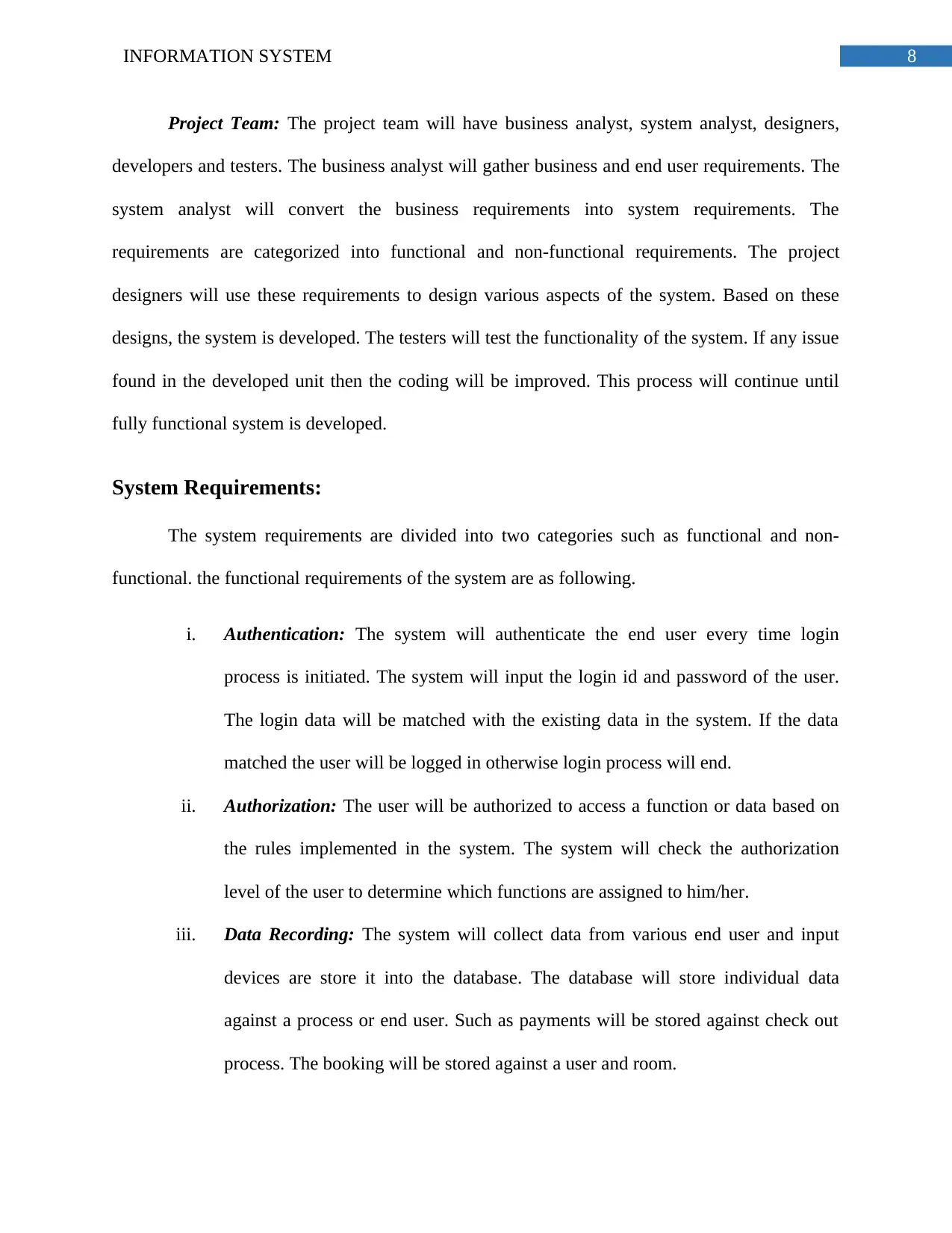
8INFORMATION SYSTEM
Project Team: The project team will have business analyst, system analyst, designers,
developers and testers. The business analyst will gather business and end user requirements. The
system analyst will convert the business requirements into system requirements. The
requirements are categorized into functional and non-functional requirements. The project
designers will use these requirements to design various aspects of the system. Based on these
designs, the system is developed. The testers will test the functionality of the system. If any issue
found in the developed unit then the coding will be improved. This process will continue until
fully functional system is developed.
System Requirements:
The system requirements are divided into two categories such as functional and non-
functional. the functional requirements of the system are as following.
i. Authentication: The system will authenticate the end user every time login
process is initiated. The system will input the login id and password of the user.
The login data will be matched with the existing data in the system. If the data
matched the user will be logged in otherwise login process will end.
ii. Authorization: The user will be authorized to access a function or data based on
the rules implemented in the system. The system will check the authorization
level of the user to determine which functions are assigned to him/her.
iii. Data Recording: The system will collect data from various end user and input
devices are store it into the database. The database will store individual data
against a process or end user. Such as payments will be stored against check out
process. The booking will be stored against a user and room.
Project Team: The project team will have business analyst, system analyst, designers,
developers and testers. The business analyst will gather business and end user requirements. The
system analyst will convert the business requirements into system requirements. The
requirements are categorized into functional and non-functional requirements. The project
designers will use these requirements to design various aspects of the system. Based on these
designs, the system is developed. The testers will test the functionality of the system. If any issue
found in the developed unit then the coding will be improved. This process will continue until
fully functional system is developed.
System Requirements:
The system requirements are divided into two categories such as functional and non-
functional. the functional requirements of the system are as following.
i. Authentication: The system will authenticate the end user every time login
process is initiated. The system will input the login id and password of the user.
The login data will be matched with the existing data in the system. If the data
matched the user will be logged in otherwise login process will end.
ii. Authorization: The user will be authorized to access a function or data based on
the rules implemented in the system. The system will check the authorization
level of the user to determine which functions are assigned to him/her.
iii. Data Recording: The system will collect data from various end user and input
devices are store it into the database. The database will store individual data
against a process or end user. Such as payments will be stored against check out
process. The booking will be stored against a user and room.
⊘ This is a preview!⊘
Do you want full access?
Subscribe today to unlock all pages.

Trusted by 1+ million students worldwide
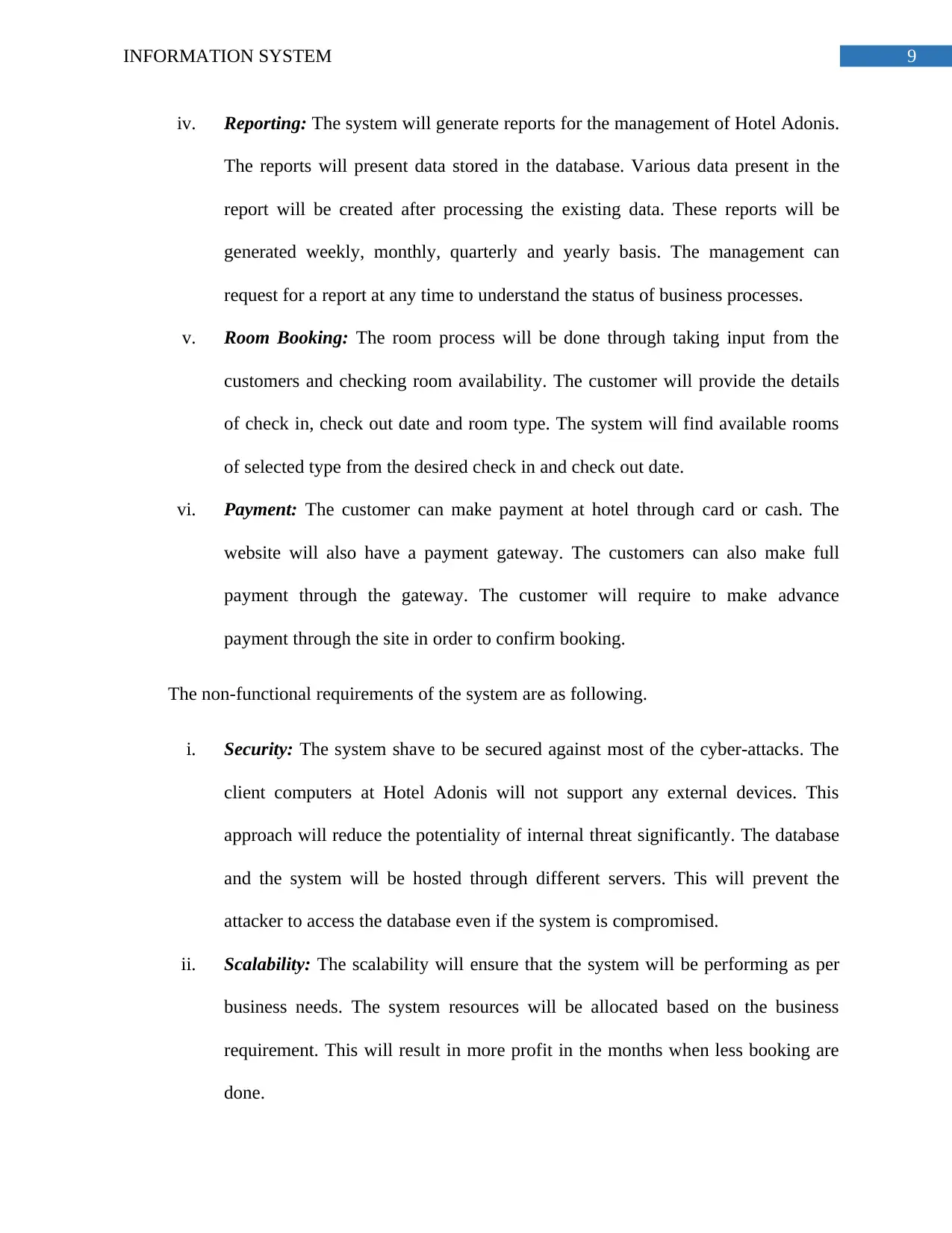
9INFORMATION SYSTEM
iv. Reporting: The system will generate reports for the management of Hotel Adonis.
The reports will present data stored in the database. Various data present in the
report will be created after processing the existing data. These reports will be
generated weekly, monthly, quarterly and yearly basis. The management can
request for a report at any time to understand the status of business processes.
v. Room Booking: The room process will be done through taking input from the
customers and checking room availability. The customer will provide the details
of check in, check out date and room type. The system will find available rooms
of selected type from the desired check in and check out date.
vi. Payment: The customer can make payment at hotel through card or cash. The
website will also have a payment gateway. The customers can also make full
payment through the gateway. The customer will require to make advance
payment through the site in order to confirm booking.
The non-functional requirements of the system are as following.
i. Security: The system shave to be secured against most of the cyber-attacks. The
client computers at Hotel Adonis will not support any external devices. This
approach will reduce the potentiality of internal threat significantly. The database
and the system will be hosted through different servers. This will prevent the
attacker to access the database even if the system is compromised.
ii. Scalability: The scalability will ensure that the system will be performing as per
business needs. The system resources will be allocated based on the business
requirement. This will result in more profit in the months when less booking are
done.
iv. Reporting: The system will generate reports for the management of Hotel Adonis.
The reports will present data stored in the database. Various data present in the
report will be created after processing the existing data. These reports will be
generated weekly, monthly, quarterly and yearly basis. The management can
request for a report at any time to understand the status of business processes.
v. Room Booking: The room process will be done through taking input from the
customers and checking room availability. The customer will provide the details
of check in, check out date and room type. The system will find available rooms
of selected type from the desired check in and check out date.
vi. Payment: The customer can make payment at hotel through card or cash. The
website will also have a payment gateway. The customers can also make full
payment through the gateway. The customer will require to make advance
payment through the site in order to confirm booking.
The non-functional requirements of the system are as following.
i. Security: The system shave to be secured against most of the cyber-attacks. The
client computers at Hotel Adonis will not support any external devices. This
approach will reduce the potentiality of internal threat significantly. The database
and the system will be hosted through different servers. This will prevent the
attacker to access the database even if the system is compromised.
ii. Scalability: The scalability will ensure that the system will be performing as per
business needs. The system resources will be allocated based on the business
requirement. This will result in more profit in the months when less booking are
done.
Paraphrase This Document
Need a fresh take? Get an instant paraphrase of this document with our AI Paraphraser
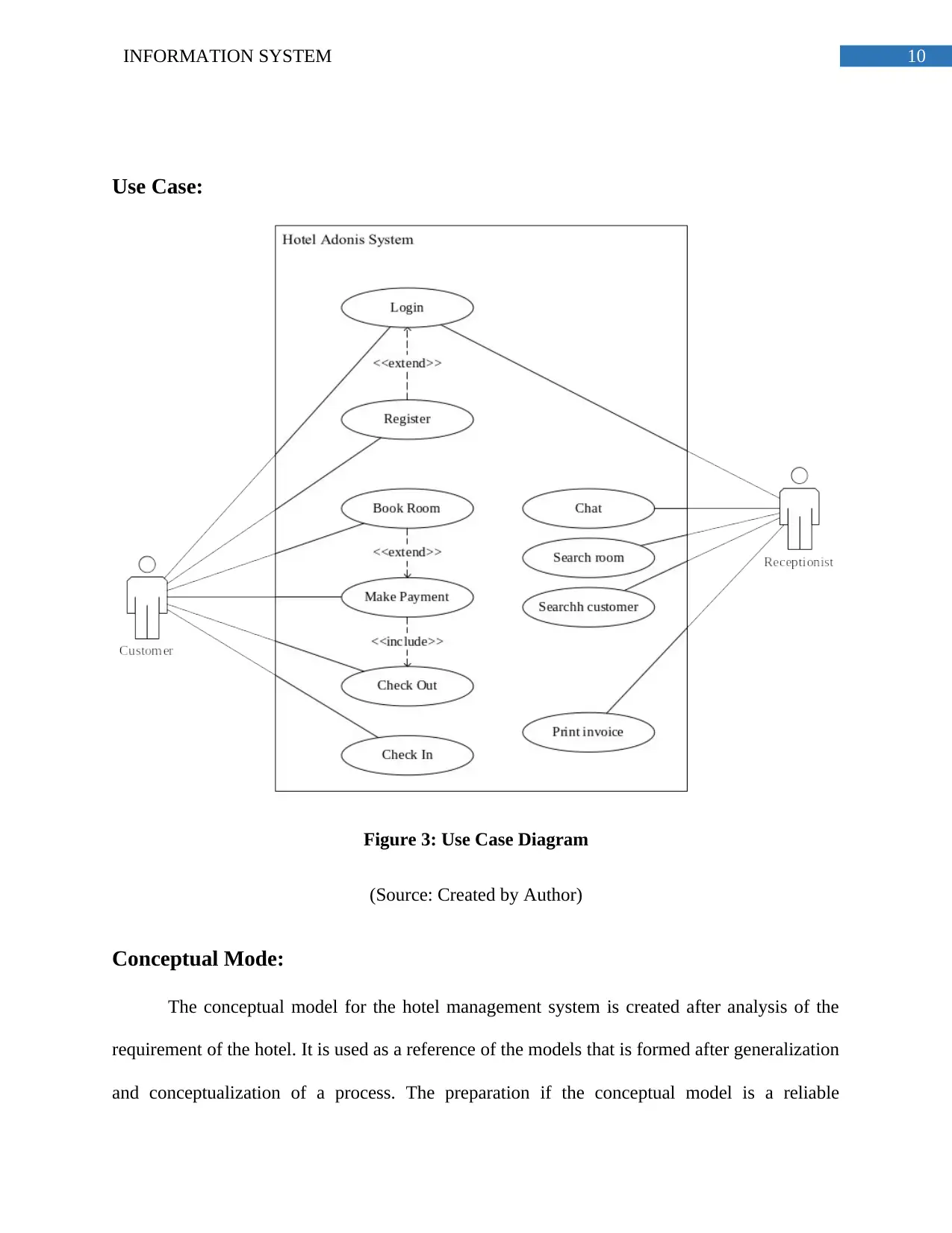
10INFORMATION SYSTEM
Use Case:
Figure 3: Use Case Diagram
(Source: Created by Author)
Conceptual Mode:
The conceptual model for the hotel management system is created after analysis of the
requirement of the hotel. It is used as a reference of the models that is formed after generalization
and conceptualization of a process. The preparation if the conceptual model is a reliable
Use Case:
Figure 3: Use Case Diagram
(Source: Created by Author)
Conceptual Mode:
The conceptual model for the hotel management system is created after analysis of the
requirement of the hotel. It is used as a reference of the models that is formed after generalization
and conceptualization of a process. The preparation if the conceptual model is a reliable
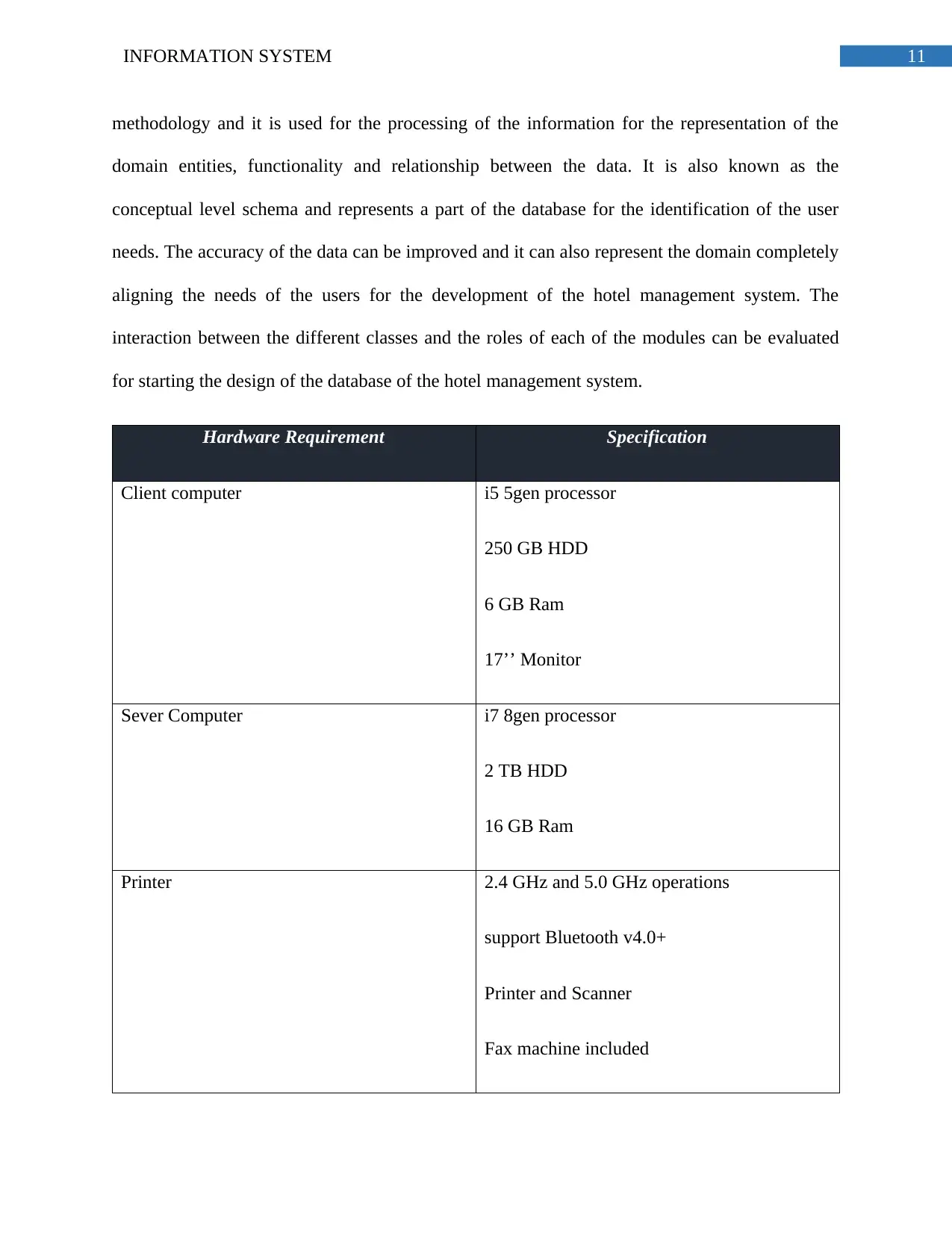
11INFORMATION SYSTEM
methodology and it is used for the processing of the information for the representation of the
domain entities, functionality and relationship between the data. It is also known as the
conceptual level schema and represents a part of the database for the identification of the user
needs. The accuracy of the data can be improved and it can also represent the domain completely
aligning the needs of the users for the development of the hotel management system. The
interaction between the different classes and the roles of each of the modules can be evaluated
for starting the design of the database of the hotel management system.
Hardware Requirement Specification
Client computer i5 5gen processor
250 GB HDD
6 GB Ram
17’’ Monitor
Sever Computer i7 8gen processor
2 TB HDD
16 GB Ram
Printer 2.4 GHz and 5.0 GHz operations
support Bluetooth v4.0+
Printer and Scanner
Fax machine included
methodology and it is used for the processing of the information for the representation of the
domain entities, functionality and relationship between the data. It is also known as the
conceptual level schema and represents a part of the database for the identification of the user
needs. The accuracy of the data can be improved and it can also represent the domain completely
aligning the needs of the users for the development of the hotel management system. The
interaction between the different classes and the roles of each of the modules can be evaluated
for starting the design of the database of the hotel management system.
Hardware Requirement Specification
Client computer i5 5gen processor
250 GB HDD
6 GB Ram
17’’ Monitor
Sever Computer i7 8gen processor
2 TB HDD
16 GB Ram
Printer 2.4 GHz and 5.0 GHz operations
support Bluetooth v4.0+
Printer and Scanner
Fax machine included
⊘ This is a preview!⊘
Do you want full access?
Subscribe today to unlock all pages.

Trusted by 1+ million students worldwide
1 out of 16
Related Documents
Your All-in-One AI-Powered Toolkit for Academic Success.
+13062052269
info@desklib.com
Available 24*7 on WhatsApp / Email
![[object Object]](/_next/static/media/star-bottom.7253800d.svg)
Unlock your academic potential
Copyright © 2020–2025 A2Z Services. All Rights Reserved. Developed and managed by ZUCOL.





